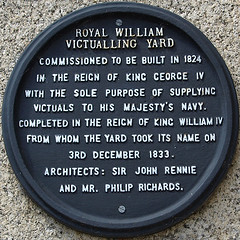Royal William Victualling Yard
Commemorated on 1 plaque
Royal William Victualling Yard commissioned to be built in 1824 in the reign of King George IV with the sole purpose of supplying victuals to His Majesty's Navy. Completed in the reign of King William IV from whom the yard took its name on 3rd December 1833. Architects: Sir John Rennie and Mr Philip Richards.
Cremyll Street, Plymouth, United Kingdom where it sited

.jpg?width=250)
